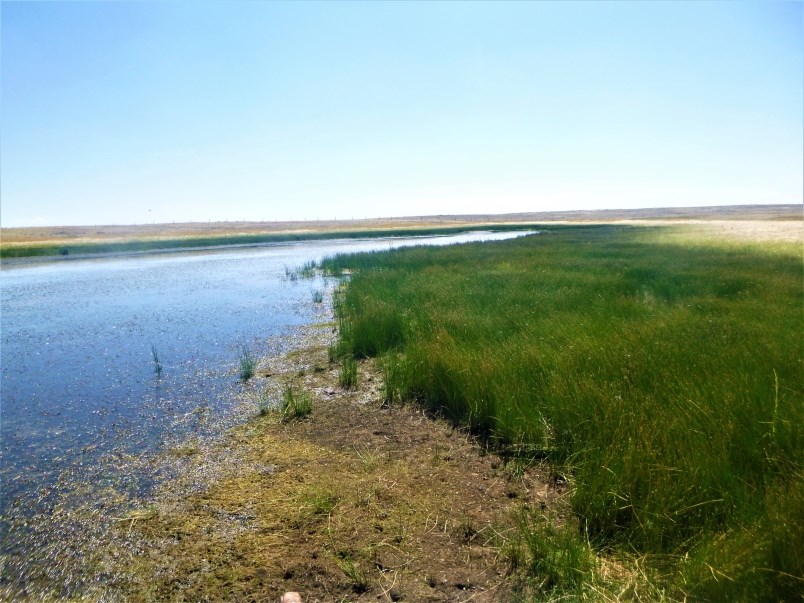A concerned citizens group focused on sustaining water ecosystems in Saskatchewan is calling on the provincial government to do more to protect wetlands, after the environment ministry announced a recent reclassification of 74,000 acres of Crown land.
“We do not see this as a good news story. The transfer of lands from one department to another will not protect wetlands nor will it resolve the wetland drainage issue in this province,” said Aura Lee MacPherson, co-chair of the Saskatchewan Alliance for Water Sustainability.
On July 2, the Ministry of the Environment announced it now has jurisdiction over 74,000 acres, which it’s adding to the Representative Areas Network (RAN). The ministry is partnering with the Saskatchewan Wildlife Federation (SWF) to manage 70,000 acres of it.
In the news release announcing the change, the ministry said the RAN is “a network of ecologically important land and water areas across the province that currently protects more than 15.8 million acres.”
Saskatchewan’s total area is more than 161 million acres; the RAN area represents 9.8 per cent of that, while the added 74,000 acres represents less than 0.05 per cent.
MacPherson said her group is “happy that these lands are going into the Representative Area Network, (but) the province needs to develop a wetland conservation policy similar to what Alberta and Manitoba have.”
Wetland policies in those provinces use ranked systems to determine the value of a given wetland area, which allows those governments to accept or decline a landowner’s request to drain a wetland for agricultural purposes. Both policies allow for wetland restoration.
She said the group’s intent is not to “point fingers;” it’s to encourage disparate government agencies and stakeholder groups to collaborate together and move away from “working in their own gopher holes.”
Another aspect of the July 2 announcement was the transfer of almost 80,000 acres of Crown land from the Ministry of Agriculture to the Ministry of the Environment; of that amount, the government listed 66,000 acres under the Fish and Wildlife Development Fund (FWDF), to be managed as wildlife habitat.
For comparison sake, Prince Albert National Park is 957,286 acres in area, or 14 times larger.
“Agriculture had a large amount of vacant Crown land that wasn't leased and was natural vegetation and basically had a high ecological value,” said Brant Kirychuk, the executive director of fish, wildlife and lands at the Ministry of Environment.
He said his team figured “that's better in environment's portfolio and it was transferred over here.”
Thirty per cent of revenue generated from fur, angling and hunting licenses in the province makes up the FWDF. The provincial government has set the following goals for the fund: “Maintain natural habitat through conservation, biodiversity, land management and awareness of rare species; maintain and grow sustainable fish populations and their habitat; maintain game populations and ensure accessible hunting.”
In its explanation of the fund on its website, the province encourages the public to support sustainable management by, among others, “planting shelterbelts (using native fruit-bearing species), protecting wetlands and sloughs, including their riparian areas (plant areas that border lakes and streams).”
Ducks Unlimited Canada is one of the partners involved in the management of FWDF lands.
“There's a host of benefits to wildlife, and there's a potential, depending on where the lands fall, there might be a grazing benefit to the livestock sector as well, potentially if the lands are suitable for grazing,” said Michael Champion, who oversees industry and government relations out of the group’s Regina office.
He said he has no critiques of the land transfer, but “there’s always more work to be done. And specifically Ducks Unlimited Canada would like to see more lands like this put in place, put into the (public) trust.”
Champion said if there are any wetlands on the transferred land, then they will “add a filtration service ... certainly wetlands protection is a key component for Ducks Unlimited, and we'd like to see more efforts to protect remaining lands in Saskatchewan.”
SWF director Darrell Crabbe said he too hopes the land transfers “pave the way for future reallocations.”
Kirychuk said most of the land transferred over from the agriculture ministry is north of Highway 16, saying FWDF lands are “scattered all over the portion of Saskatchewan south of Prince Albert, Meadow Lake and Hudson Bay.”



